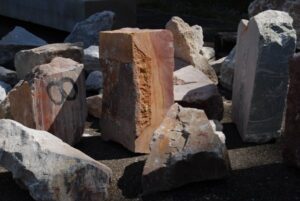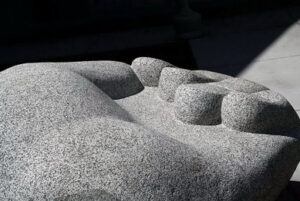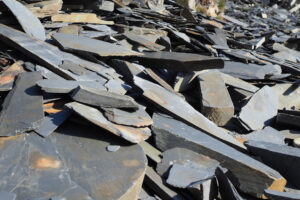
Home » Carve » Hard Stone » The Stone Column: Granite – May/June 1996

Granite is a magnificent rock that has adorned cities for centuries. It is treasured for its beautiful texture as well as its multitude of utility. It not only flaunts itself in polished monuments, statues and intricate sculptures, but provides foundations for buildings, curbs for streets and steps for stairs.
It is undoubtedly the world’s dimension building stone and the stone of the world’s bygone heroes and heroines. Brilliantine reds, pinks, blacks, grays, and whites continue to sparkle century after century as other stones turn to clay and dust. Hard granite is no stone for the weak hearted or the limp wristed; the beauty of the stone must be earned by hard work. Some of the most noted mountains in the United States are, by no mistake, granite massifs: Stone Mountain and Mount Rushmore, both with their carved historical figures; the Old Man in the Mountain, Mother Nature’s carved face; Mount Monadnock; and, closer to home in the Pacific Northwest, Mount Index
One of the most fascinating features of granite is that it is comprised of so many minerals. It is that combination of the different minerals and sizes of crystals that gives granite so many appearances. The major constituents of granite are quartz, plagioclase feldspar, potassium feldspar, biotite, and hornblende.
We need to make a distinction between common usage of the term granite and the geologist’s version of the word. The commercial use of the word is considerably broader than the geologic use. To geologists, true granite is a very limited occurrence of the rock that contains more than 10 percent quartz, greater than 2/3 potassium feldspar, along with biotite and hornblende, and is very light in color; generally with dark specks. All of the other versions are granitic rocks that have specific names that are defined by the percentages of the major constituents. The common lighter colored granitic rocks are quartz monzonite, granodiorite and quartz diorite and diorite, in order from light to dark.
The very dark or black granites are diabase, gabbro, anorthosite and pyroxenite, biotite and hornblende. Quartz is the glassy one; the feldspars are the opaque ones; biotite is black mica and hornblende is the black, lathe-like mineral. Other minerals that commonly find their way into granitic rocks are magnetite, ihnenite, apatite, pyrite, zircon, allanite, tourmaline, olivine and muscovite.
The granitic rocks come in a wide variety of colors: white, many shades of gray, yellow, pink, red, black and green. The hardness of the rock depends on the rocks constituents. Quartz is a 7 on Mohs Hardness Scale and fresh, unweathered feldspar is about 6. Because these two minerals comprise nearly all of the volume of the rock, the average would be about 6.5. It is the hardest of the common carving stones. It has a unit weight of 160 to 170 pounds per cubic foot for light-colored granite, whereas black granite can range from 170 to 185 pounds per cubic foot. It has a compressive strength of 10,000 to 20,000 pounds per square inch, one of the stronger rock types in the world.
There are two schools of thought regarding the formation of granitic rock: intrusion and granitization. For many years, the main hypothesis was that granite formed below the earth’s surface, from the slow cooling of intrusive molten rock. These intrusive rocks cool so slowly that growth of individual crystals is enhanced by the extension of the cooling process. In general, the slower the cooling, the larger the minerals; whereas, the fine grained minerals cooled much faster. Within the intrusive body, zones of different grain sizes can be mapped. Enormous intrusions are called batholiths, i.e., the Sierra Nevada; smaller intrusions are termed plutons, i.e. being the Snoqualmie and Index plutons in the Cascades.
On the other hand, in granitization, granite forms by the slow change in the country rock by a “soaking” of adjacent fluids, causing mineralogic replacement. In this way, during regional metamorphism, large bodies of existing rock are converted to granite. In some cases, magma has been injected into layers of existing rock and the molten fluids have then contributed to the granitization of the intervening rock. Apparently, enough examples of each type of activity have been found, and laboratory experiments have been performed to support each hypothesis.
One of the more interesting characteristics of granitic rocks, and one that is important to road builders, quarrymen and sculptors alike, is the right-angle jointing pattern. Owing to the combination of the immensity of the granitic bodies and regional stresses in the ground subsequent to their formation, a joint (crack) pattern develops. In most cases, there are two joints that are vertical and at right angles to each other and another set that is horizontal. Therefore, in many cases the rock blocks are rectangular, although wedge-shaped blocks develop from odd-angle joints. Very commonly, the rock along the joints is stained red or black with iron or manganese oxide precipitates from the periodic rurming of ground water. For road building, quarrying and sculpting it is preferable to have the joints as widely spaced as possible. Another related feature is sheeting; a joint set that runs parallel to the ground surface. It is thought to be caused by the release of stress from the removal of overburden. This can be seen dramatically on Stone Mountain in Georgia.
The retrieval and quarrying of granitic rocks depends on the use of the stone. For general use of the rock as crushed road surfacing, railroad ballast, riprap or landscaping rock, blasting is suitable. One particularly deleterious effect of the blasting is that is also imparts or opens up existing micro fractures in the pieces that are created. Rock blocks that are removed from talus slopes at the foot of a rock cliff in mountainous areas that are used for landscaping also contain these imperfections. These microfractures could ruin a monument or sculpture piece. Therefore, granite from these types of sources is not used for monuments or sculpture.
Granite for monumental or sculpture pieces is obtained in several ways: utilizing natural joint planes, drilling and very light blasting, deep drilling of closely spaced holes in a line, sawing with a wire, jet piercing and high pressure water. Wherever possible, sheeting planes are used for horizontal separation.
Although the Washington Cascades contain much granitic rock, very little of it is used for sculpture or monuments. One reason is that it does not have the attractive hues that appeal to people, but the primary reason is that regional earth stresses have created too many joints for it to be suitable. In general, it takes a 10- to 30-foot spacing of the two major joint planes to allow large rectangular blocks to be successfully and economically hewn.
Several factors are important when choosing a piece of granite for a sculpture, among them rock source, color, mineral grain size and homogeneity. As discussed above, the origin and quarrying of the rock is a concern, because a sculpture piece of intricate detail is very susceptible to micro fractures during sculpting and requires a carefully quarried block. On the other hand, a large piece from which little removed may be amenable to a blasted or talus rock.
While color of the rock is very important because it must be artistically compatible with the subject, the size and consistency of the mineral grains are, by far, the most important properties to consider when selecting a granitic stone. It is preferable to find a stone that is fine to medium grained. As a general guideline, the finer the grain, the easier the rock is to work. During the final surface preparation with a medium to coarse grained stone, it is necessary to use a grinder rather than percussion tools so that damage of single or groups of larger crystals do not spoil the piece.
In granite monuments and sculpture pieces, consistency of color and grain throughout the piece is essential. Two types of flaws must be considered when selecting or working the stone: foliation and xenoliths. Foliation is the alignment of minerals or streaking that develops when the rock is moved or pressured during or after the cooling of the rock. While there are some granites that have beautiful and consistent foliation, it is more commonly haphazard and can interfere with the sculptured piece. Xenoliths are foreign rock bodies within the granite that were incorporated into the pluton or batholith during its expansion into the country rock. They are usually of different color and hardness (harder or softer) than the granite, and therefore, can be troublesome.
Because it is one of the hardest commercially sculpted stones, granite requires bigger and more sophisticated tools, when compared to many of the other sculpting stones. Power is a necessary part of the granite worker’s tool bag. There are sculptors who use hammer and chisel on granite, as reported in Sculpture Northwest in July 1992 by Myrna Orsini about a trip to the Ukraine; however, hand work of granite is very difficult and time consuming. No matter what the energy source, carbide-tipped tools and diamonds are essentials for working this wonderful rock.
Some stones require little removal of stock, because the sculpted portion is a small portion of the finished piece or because the rough, natural rock has already spoken to the sculptor about its final disposition. In these cases, only a flat bottom must be established and then negative space developed from the rest of the natural stone.
On the other hand, when a significant amount of stock must be removed, the following process is typical. First, one or more flat surfaces must be established. This is accomplished by establishing a plane with nine points on the desired surface. Removal of the rock between the reference points can be done with a torch or an angle grinder. An angle grinder is more efficient when more than a 1/4-inch is to be removed (more on the torch later). The angle grinder is used to score the rock to a maximum to 1-3!4-inches deep and 1/2- to I-inch between cuts. The rock between the deep scores is then removed with a hand point or a pneumatic chipper.
The next step is removal of negative space with a four-point pneumatic carver’s tool. The tooth size of the chisel should be proportional to the grain size of the stone. As the shape of the piece becomes more apparent a criss-cross point can be used, because it is easier to control and hold flat against the piece. Once the desired shape is reached, a clean-up flat chisel is used to take out the marks from the other tools. A wider flat chisel is better than a narrow one, because it leaves fewer intervening marks. To work nooks and crannies, specialty or hand-made tools are necessary. Every sculptor has many of these one-of-a-kind tools for special hard to reach places.
Polishing of granite is accomplished with diamond sand paper pads, ranging from 80 to 3600 grit. Pads for both hand and power polishing can be purchased. A good polish can be achieved with 1800 grit; however, 3600 grit can impart an even more beautiful luster, if time and energy allow. Waxes on granite are a personal preference, and to a large degree, are also dependent on whether the piece will reside indoors or out.
Demonstrations of the removal of granite stock with an oxy-acetylene torch have occurred at workshops in the past. Although the cost of the equipment and gases must be taken into account, its quick and efficient removal of stone is impressive and a significant addition to the sculptor’s bag of tricks.
Thanks to sculptor Signature Theship, formerly of Seattle, Washington, to rock purveyor Ray Reeves of Marenakos Stone Center of Preston, Washington and monument dealer Bill Cantelon of Quiring Monuments in Seattle, Washington for sharing their knowledge and expertise of granite.








We need some kind of descriptive text here.